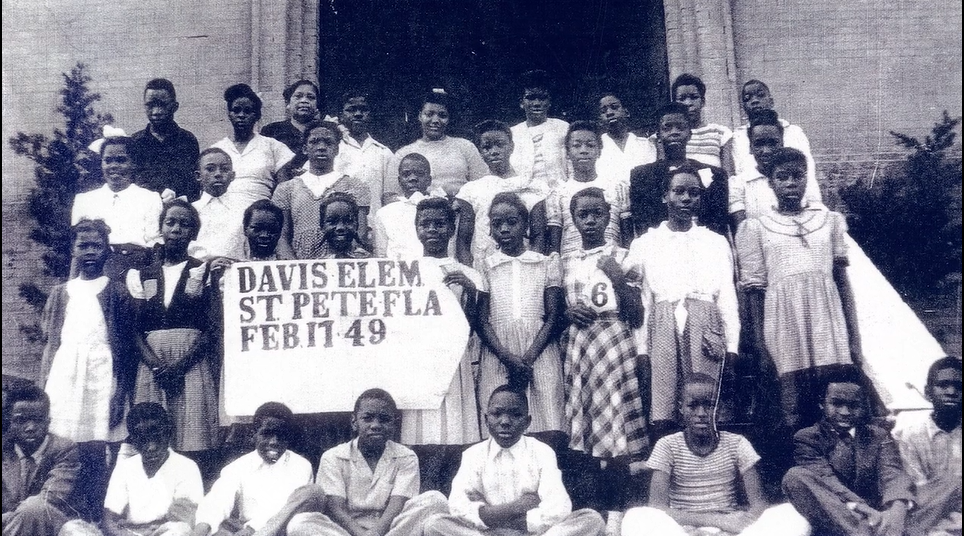Before Gibbs High School opened in 1927, Pinellas County had no school for Black students past the sixth grade.
By Gwendolyn Reese
In 1910, Davis Academy, later to become Davis Elementary, opened as the first formal school for African Americans. The school, located at 950 Third Ave. S, was the city’s only learning institution for black children.
The school term was six months compared to the nine months for white students and black teachers were paid far less than white teachers. The curriculum focused on manual training and domestic science.
Davis Academy was a three-storied building with 14 classrooms. Early principals were G.T. Wiggins, Emma Booker, Regina McLin Blye, John Hopkins, Amanda Howard and William Thompson.
Education for most black students ended in sixth grade. Those who pursued a high school education had to relocate to Jacksonville, Live Oak, St. Augustine, Daytona Beach or Tallahassee to attend a church-related or private school. Black colleges in those days usually had prep schools where blacks could get ready for college admission while on a college campus.

In 1910, Davis Academy, later to become Davis Elementary, opened as the first formal school for African Americans.
For many years, Davis Elementary was the only school for black children in St. Petersburg. With the influx of African Americans in the 1920s, the school quickly became overcrowded and Jordan Elementary was built.
Jordan Elementary opened in 1925 with nearly 1,100 students, 21 teachers, and George W. Perkins as principal. Other early principals were Mrs. Marie Pierce, Emanuel Stewart, Louis McCoy and Fred Burney.
The school was named in honor of Elder Jordan Sr., who donated the land for the school and parts of the Jordan Park housing complex. He was a prominent builder and developer who settled in St. Petersburg in 1904 with his wife Mary Strobles and their five sons.
According to Sandra Rooks, author of “Black America Series: St. Petersburg Florida,” Jordan Elementary pioneered in radio broadcasting a school chorus, having the first home economics classes for boys, PTA organization, free night classes for adults, double sessions, and reading clinics for blacks.
Students were also engaged in various special projects as noted in a newspaper article in the Negro News of St. Petersburg and Pinellas County dated October 1, 1944. The article reported that more than 710 Jordan pupils enthusiastically packed boxes to be turned over to the local Red Cross chapter for shipment to soldiers overseas.
Dear Ole Gibbs High School

Gibbs High School bears the name of Jonathan Clarkson Gibbs, a clergyman and the first black man ever to hold a cabinet position in Florida.
“Gibbs’ greatest treasure is its heritage, and its story is the story of the black community from which it was raised.”
This quote from the school district’s history book summarizes what Gibbs High School means to this community. Former principal Emanuel Stewart was once quoted saying, “We were one of the few Florida black schools that didn’t close during integration.”
Originally named the Thirty-Fourth Street Colored School, the school was renamed Gibbs High by students and faculty in 1928. Gibbs bears the name of Jonathan Clarkson Gibbs, a clergyman and the first black man ever to hold a cabinet position in Florida.
He served as secretary of state during Reconstruction and later held the position of state superintendent of public instruction. Gibbs graduated from Dartmouth College and later studied at Princeton Theological Seminary for two years.
The school started as an eight-classroom facility. Under the leadership of George W. Perkins, the campus grew to include a chemistry lab, tennis courts, gymnatorium and cafeteria.
Getting to school wasn’t easy because the county did not provide bus service for black students. In the book “St. Petersburg’s Historic 22nd Street South,” co-authored by Rosalie Peck and Jon Wilson, Ralph James—my chemistry teacher at Gibbs—is said to have roller-skated to school.
George Grogan, George Perkins, and two teachers pledged their salaries to help guarantee payments on the black community’s first school bus nicknamed the “Blue Goose.”
Early principals serving Gibbs were Samuel Reed, G.W. Perkins, Theresa McKinney, Rev. John Carter, Noah Griffin, Andrew Polk, John Rembert, Emanuel Stewart and Cecil Keene. McKinney was the first woman principal of a high school in Pinellas County.
Sources:
St. Petersburg Times News of Negroes in St. Petersburg and Pinellas County, 1944; Black America Series St. Petersburg Florida, Sandra Rooks; Remembering St. Petersburg Florida, Scott Hartzell; St. Petersburg’s Historic 22nd Street South and St. Petersburg’s Historic African American Neighborhoods, Rosalie Peck & Jon Wilson










Ms. Reese, I am putting together a 90th Anniversary edition of the Gibbs High School yearbook. Would you consent to allowing me to put the section of this article relating to Gibbs in that yearbook? I would give you full credit, with your lovely photo included. 🙂 I am the librarian at Gibbs, if you would reach out to me at the school, or via email, I would greatly appreciate it. Thank you.